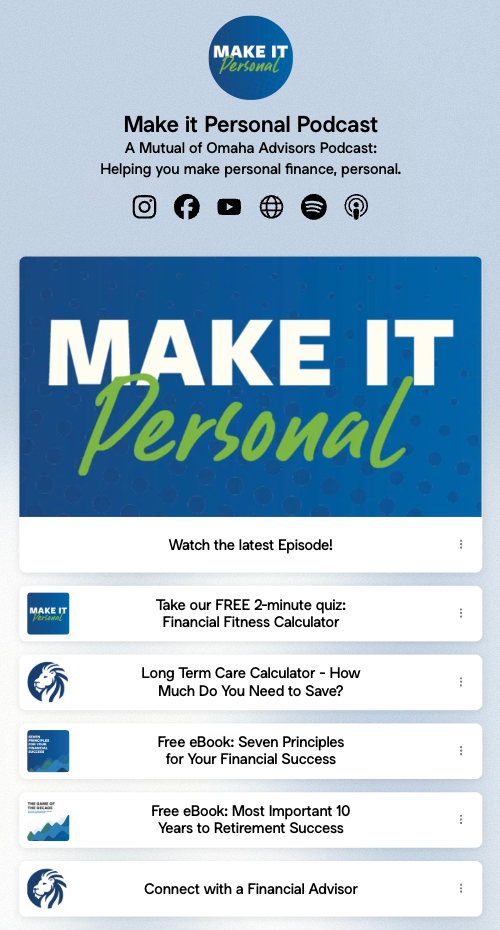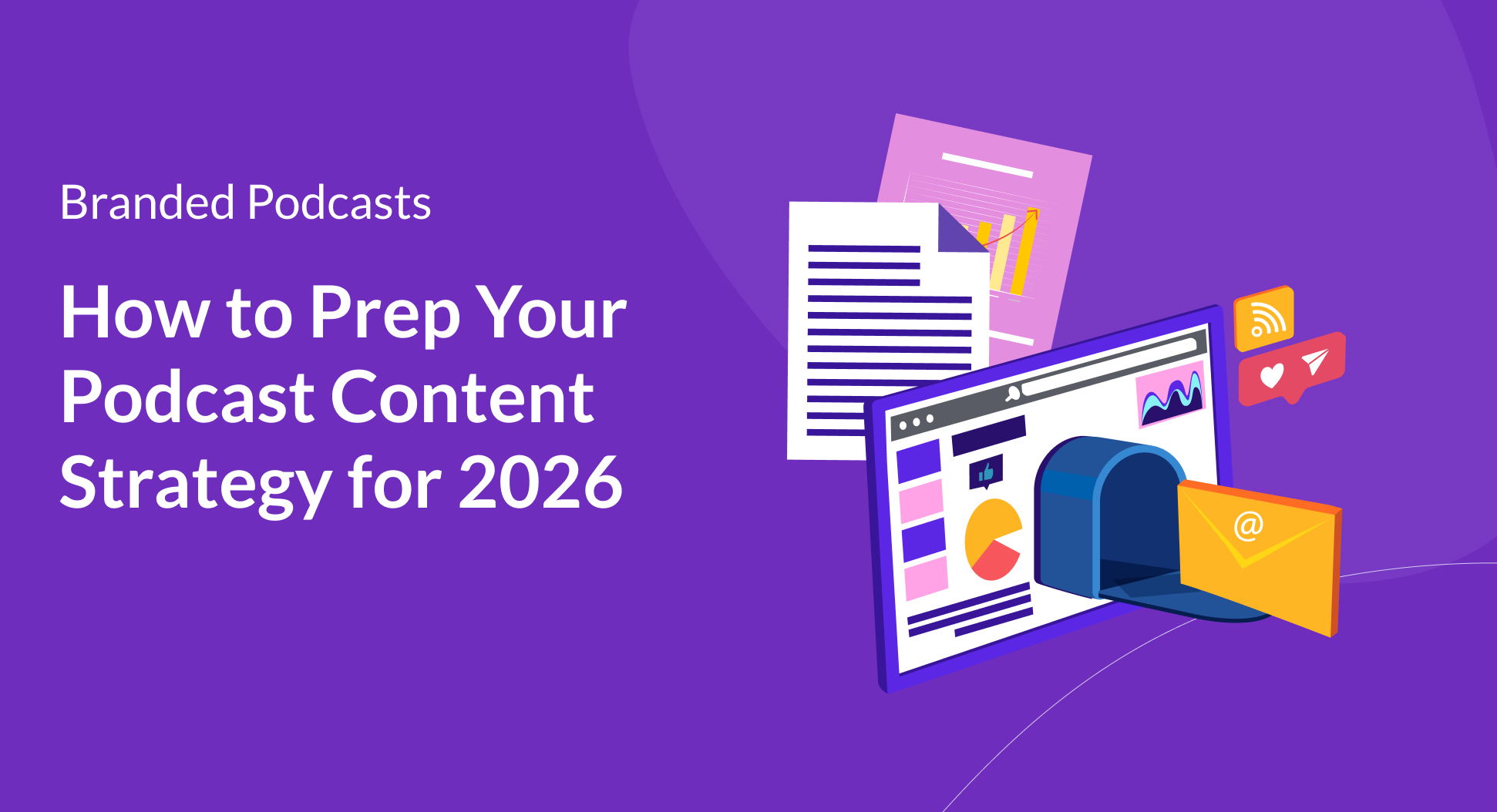Contents
When most people think of storytelling in podcasts, they imagine murder mysteries, personal testimonials, or fictional series. But in reality, storytelling is at the heart of every effective podcast — even branded shows that aren’t “narrative-first.”
Across marketing, brand storytelling has become a recurring theme, and for good reason: stories help people understand what a brand stands for, why it exists, and how it fits into their world. In audio, this becomes even more powerful. A podcast doesn’t need a plot or characters to leverage storytelling — it simply needs a clear point of view, a relatable message, and a structure that helps listeners connect the dots.
That’s why branded podcasts work. Whether you’re sharing industry insights, unpacking customer challenges, or highlighting the people behind your company, your show is still telling a story. The key is being intentional: understanding your audience, aligning each episode with your brand values, and creating an experience that feels human rather than promotional.
In this blog, we’ll be isolating tips and strategies from Mutual of Omaha’s podcast, Make It Personal, to show you how to incorporate brand storytelling into your company’s podcast – the right way.
TL;DR: Storytelling in branded podcasting
- Narrow your niche: Focus on a specific audience and create content that speaks directly to their challenges, interests, and goals. By targeting the right listeners, your podcast becomes a storytelling tool that turns each episode into a meaningful interaction.
- Define your unique perspective: Stand out by sharing your brand’s distinctive point of view. Consistently offering insights, stories, and advice only your brand can provide builds credibility and positions your podcast as an essential resource for your listeners.
- Amplify your story beyond the airwaves: Repurpose your episodes into videos, blogs, social snippets, guides, and interactive tools to extend your brand’s narrative across multiple touchpoints. Every piece of content reinforces your story and keeps your audience engaged wherever they are.
Introducing Make it Personal
Make It Personal is a weekly podcast by Mutual of Omaha designed to help you cut through the noise and focus on what really matters: taking control of your finances and building the future you want.
Each episode breaks down big financial concepts into practical, everyday advice you can actually use. From understanding how the Federal Reserve’s rate changes affect your wallet, to uncovering the quiet habits that help millionaires build wealth, and even exploring what it means to leave a lasting legacy beyond money, they cover it all.
Whether you’re tackling debt, saving for a first home, or just trying to make smarter financial decisions, Make It Personal turns headlines into helpful steps and ideas into action.
Branded Podcast Storytelling Techniques
1. Narrow your niche
Trying to speak to everyone is the fastest way to end up speaking to no one. Narrowing your niche is about knowing exactly who you’re talking to and focusing your content on their needs. Instead of covering broad topics like “finance” or “marketing,” figure out who will actually benefit from your podcast — and tailor your content to their interests and needs.
For branded podcasts, this focus is especially valuable. A smaller, well-defined audience listens more closely, trusts the host, and engages with the content. That engagement matters more than raw download numbers because it reflects real interest in your brand. The data backs this up:
- 60% of listeners say niche podcasts offer deeper value and insights than mainstream programming.
- 60% of listeners said they find niche podcasts more engaging, and 59% said they have a stronger connection and loyalty to them.
- 63% of listeners said they’re less likely to skip advertisements from niche podcasts as opposed to mainstream podcasts.
Focusing on a niche also positions your podcast as a resource people come back to. When your episodes consistently address a specific set of challenges or interests, your show becomes relevant, memorable, and easier to discover. For brands, that kind of focus turns a podcast into a meaningful tool for connection and influence.
Niching Down in Make it Personal
Make It Personal shows how narrowing your niche works in practice. Instead of covering every financial topic, the show focuses on personal finance strategies that their target listeners can actually apply. Episodes explain real-world topics without jargon, giving listeners tangible takeaways.
This focus attracts an audience that’s actively interested in improving their financial well-being. It’s not about reaching millions; it’s about reaching the right people and providing content they find useful.
2. Define your unique perspective
In branded podcasting, your perspective is your differentiator. It’s the lens through which you tell stories, choose guests, shape conversations, and highlight what your brand stands for.
What many brands get wrong is assuming they need to copy what’s already working in their industry — same angles, same topics, same talking points. But if your show sounds interchangeable with a competitor’s, it’s not telling your story or providing any new value to your target audience.
Brand storytelling works best when it reflects your values, your expertise, and the specific problems you help your audience solve. And when you show up consistently with that point of view, your podcast becomes an experience people connect with.
A unique perspective also makes your content more strategic. It keeps you from creating generic episodes and forces you to ask:
- What do we know that no one else is saying?
- What stories can only our brand tell?
That clarity helps the podcast stand out in crowded listening apps and gives your audience a reason to choose your show over dozens of similar ones.
Unique value in Make it Personal
Make It Personal reflects this brand storytelling approach by grounding its entire show in a single, clear perspective: financial guidance that feels personal, practical, and doable. Instead of following the broader finance podcast playbook — market forecasts, headlines, or high-level advice — the show stays focused on how financial decisions impact real people’s everyday lives.
This angle aligns directly with Mutual of Omaha’s brand promise: empowering people to plan with confidence. Every episode reinforces that identity through storytelling. Complex topics, like rate cuts or legacy planning, are translated into relatable narratives and realistic next steps. Episodes highlight behaviors, habits, and decisions listeners can actually take, which builds trust and positions the brand as a guide rather than a lecturer.
3. Amplify your brand’s story beyond the airwaves
A branded podcast shouldn’t live in a vacuum. When you publish an episode and stop there, you’re only capturing a fraction of its value.
The stories, insights, and conversations inside your show can — and should — fuel your entire brand ecosystem.
For most brands, a podcast is often the deepest, richest storytelling asset they produce. Repurposing takes those moments and turns them into a steady stream of touchpoints that reinforce who you are, what you stand for, and why your audience should care. Instead of starting from scratch for every channel, you’re building from the strongest version of your story.
Some common ways to repurpose branded podcast content include:
- Short video clips and audiograms: Pull out the most engaging 10–30 second moments from your episodes and use them as hooks across your social media.
- Blog posts or articles: Take key moments from each episode and turn them into stand-alone blog posts for those who prefer reading over listening.
- Email newsletter segments: Feature episode highlights, blog posts, or guest tips to engage your subscriber base and encourage them to tune into full episodes.
- Long-form guides or eBooks: Expand multi-episode themes into resources that establish authority and act as evergreen lead magnets.
- Infographics or visual explainers: Simplify complex data or frameworks discussed in the podcast into visuals your audience can quickly understand and share.
- SEO-optimized transcripts: Publish transcripts on your site to improve discoverability and support accessibility.
Make it Personal’s content ecosystem
The team behind Make It Personal isn’t just publishing a weekly podcast and calling it a day — they’re building a full ecosystem around the show that supports their brand story and gives listeners multiple ways to engage. Their Linktree page highlights this clearly: the podcast is linked to social channels, video content, free eBooks, financial quizzes and calculators, and more.

Here’s how their ecosystem works to amplify the brand story:
- Free eBooks like “Seven Principles for Your Financial Success” and “Most Important 10 Years to Retirement Success” are built on the topics discussed in episodes. These assets deepen the brand’s authority and offer value to those who would rather read than listen.
- Quizzes and calculators, like “How are you doing financially?” help turn passive listening into active engagement.
- Social media profiles, like Instagram and Facebook, extend the podcast’s story into popular platforms where Mutual of Omaha’s audience already spends their time. This supports a cohesive brand narrative across formats.
When listeners see the podcast, the eBook, the quiz, and the social posts all working together, the brand message becomes clear: we’re here to help you take control of your money in a way that actually makes sense. It’s not just one episode showing up in their feed—every touchpoint reinforces the same story.
Bring your brand’s story to life
Make It Personal demonstrates how a clear point of view, focused content, and consistent messaging can turn a podcast into a powerful storytelling tool that connects with listeners on a human level.
By narrowing your niche, defining your unique perspective, and amplifying your episodes across multiple channels, Mutual of Omaha shows how branded podcasts can do more than inform; they can build trust, foster engagement, and reinforce a brand’s identity across touchpoints.
The key takeaway? Every episode, every piece of supporting content, and every interaction should work together to tell your brand story in a way that feels authentic, practical, and meaningful to your audience.
Don’t forget to tune into Make It Personal wherever you get your podcasts. Plus, for more branded podcast strategies like these, subscribe to our bi-weekly newsletter, The Branded Podcaster.






.png)

.png)




.png)
.png)
.png)
.png)